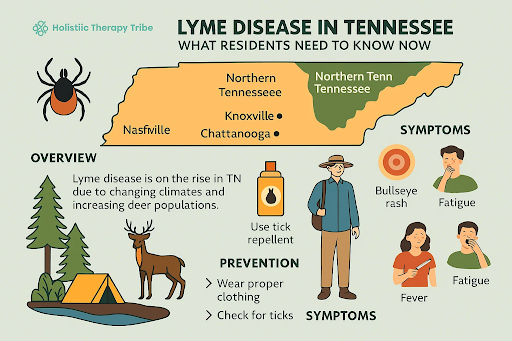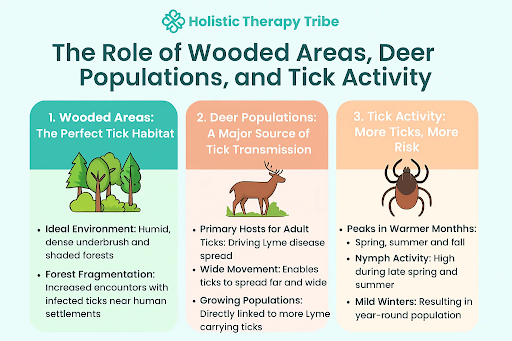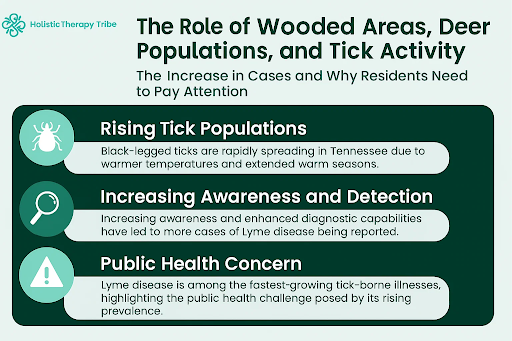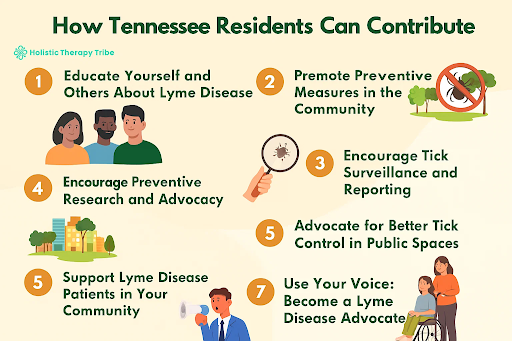


How Tennessee Residents Can Contribute

Lyme disease is a growing concern in Tennessee. Thus, raising awareness is vital to control the spread. Residents of Tennessee can aid in preventing Lyme disease by acting, educating others, and contributing to public health strategies. Here is how one can help:
1. Lyme Education and Awareness:
- Identify and learn about the symptoms and familiarize with it. The more you know, the quicker you can spot.
- Residents can work with local health departments or Lyme disease advocacy groups. One can distribute pamphlets, posters, and online resources at schools, community centres, and workplaces to educate the communities.
- Social media has a power and a leverage by sharing educational posts, infographics, and articles about Lyme disease. One can use hashtags such as
#LymeDiseaseAwareness and so on to engage with the communities and spread the message.
2. Promote Preventive Measures:
- Hold tick prevention campaigns to encourage the community to take preventive measures to avoid tick bites.
- Host Local Workshops or community talks in collaboration with the health organizations. At such places, the local experts can teach and guide about Lyme disease prevention, tick removal, and the importance of the seeking medical professional.
- Associate with schools and educational institutions to create awareness among children and their families. One can distribute educational materials and encourage students to educate their parents.
3. Encourage Tick case reporting and surveillance:
- Report the suspected Lyme cases to the Tennessee Department of Health to encourage accurate tracking of Lyme disease prevalence. Accurate data can aid in effective public health measures.
- Support the health departments to monitor the tick populations and the spread of Lyme disease. This can aid in tracking the Lyme hotspots and locate the risks in local areas.
4. Support Lyme Disease Research and Advocacy:
- Join the community groups and become an active member of Lyme disease advocacy groups such as American Lyme Disease Association on national level or Holistic Therapy Tribe on global basis.
- Raise Funds for Research! Organize fundraising events to support research on Lyme disease treatment, prevention, and public education efforts.
- Contact the local lawmakers and advocate for strong Lyme disease- related policies that will encourage Lyme disease education, prevention, and funding for research.
- Volunteer for Lyme Disease Awareness Campaigns assist in organizing community events, educational sessions, or fundraising efforts for Lyme disease.
5. Become a Lyme Disease Advocate:
- Use your voice!
- Write or engage with writeups online or support and engage with the opinion pieces or letters to local newspapers highlighting the importance of Lyme disease awareness and prevention. This can help in engaging with larger audiences and encourage residents to take preventative measures.
Support Groups and Community Networks

Local and State Resources for Lyme Disease Sufferers
- Biologix Centre for Optimum Health – Franklin, TN (Link)This health center focuses on a holistic approach and individual care plans. It offers both the medicinal and functional approach to Lyme disease and tick- related conditions.
- Knox Wellness Experience – Knoxville, TN (Link)They offer personalized treatment plans that may include antibiotics, detoxification, and immune system support to address the complexities of Lyme disease.
- ILADS (Link)ILADS is a non-profit medical society focused on the diagnosis and treatment of Lyme and associated diseases.
- Holistic Therapy Tribe- Lyme Disease Community Network. It is an online community network that focuses on holistic therapies for various health conditions, including Lyme disease. The group is a part of a larger platform aimed at providing education, support, and resources related to natural healing and holistic wellness.
- Lyme Disease Network (Link) Their mission is to dispel myths and misconceptions surrounding Lyme disease and other tick-related illnesses. Offers information on Lyme disease prevalence and prevention in the region. Provide specialized care for neurological symptoms associated with Lyme disease.
- Tennessee Lyme Support – Facebook Group It is a private Facebook group dedicated to providing a safe, supportive space for residents of Tennessee who are affected by Lyme disease and other tick-borne illnesses.
Conclusion
- Lyme disease is increasingly becoming a public health concern in Tennessee, with the rise in cases attributed to factors such as expanding tick populations, climate change, and increased human activity in wooded areas.
- Raising awareness and providing education about Lyme disease prevention are key steps in reducing its spread. Additionally, understanding the early symptoms of Lyme disease—such as the bullseye rash, fatigue, and joint pain—can lead to quicker diagnosis and treatment, reducing the long-term impact of the disease.
- As Lyme disease continues to spread, Tennessee residents can contribute to the fight by educating themselves and others, reporting suspected cases, and supporting public health initiatives aimed at monitoring tick populations. Together, these efforts will not only help reduce Lyme disease rates but also ensure a healthier future for Tennessee communities.
What’s Next for You?
Ready to explore a more complete path to recovery? Join the Lyme Support Network Community.
References
- Tennessee Department of Health. Lyme Disease Overview. Tennessee Department of Health. Lyme Disease Overview. Accessed July 12, 2025. Link
- Centers for Disease Control and Prevention. Lyme Disease Surveillance and Data.Accessed July 12, 2025. Link
- Clayton JL, Jones SG, Dunn JR, et al. Enhancing Lyme Disease Surveillance by Using Administrative Claims Data, Tennessee, USA. Emerg Infect Dis. 2015;21(9):1632-1634. doi:10.3201/eid2109.150343 Link
- National Science Foundation. Fighting the Spread of Lyme Disease.Accessed July 12, 2025. Link







